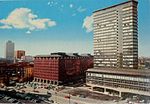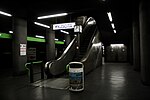Torre Diamante

The Diamond Tower (in Italian Torre Diamante or colloquially Diamantone) is a high-rise building in Milan business district, on the corner between Viale Della Liberazione and Via Galilei. It was built in the context of a massive urban renewal project carried out at the start of the 21st century. The tower is 140 meters tall, making it the fourth building in Milan by height and the fifth in Italy and the tallest steel edifice in Italy. It features an iconic multifaceted structure, which recalls the shape of a diamond (from which, indeed, derives its name). The building is surrounded by some lower constructions, nicknamed Diamantini (the small diamonds), functioning as continuities of the high-rise. All the facilities are intended for commercial purposes. The principal tenant is BNP Paribas bank since 2016.
Excerpt from the Wikipedia article Torre Diamante (License: CC BY-SA 3.0, Authors, Images).Torre Diamante
Via Mike Bongiorno, Milan Municipio 9
Geographical coordinates (GPS) Address External links Nearby Places Show on map
Geographical coordinates (GPS)
| Latitude | Longitude |
|---|---|
| N 45.481054444444 ° | E 9.1962486111111 ° |
Address
Torre Diamante (Diamantone)
Via Mike Bongiorno
20124 Milan, Municipio 9
Lombardy, Italy
Open on Google Maps








